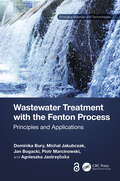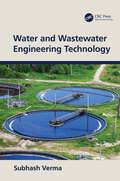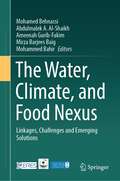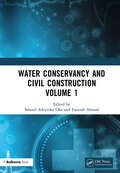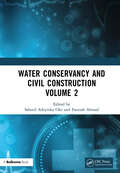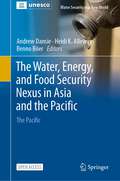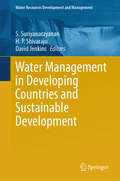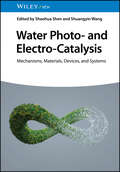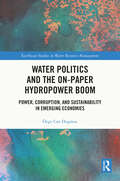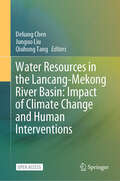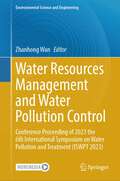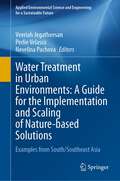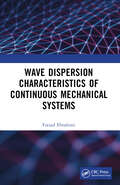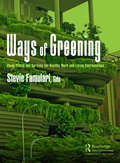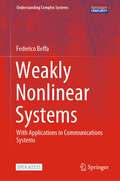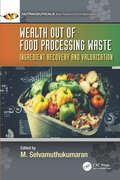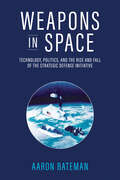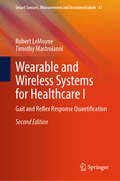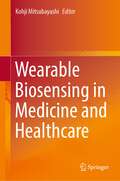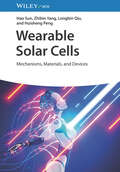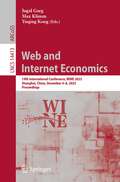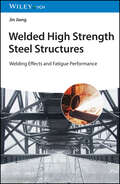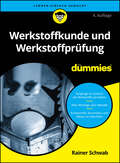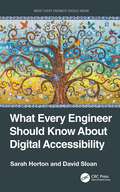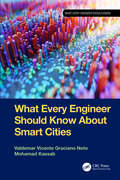- Table View
- List View
Wastewater Treatment with the Fenton Process: Principles and Applications (Emerging Materials and Technologies)
by Dominika Bury Michał Jakubczak Jan Bogacki Piotr Marcinowski Agnieszka JastrzębskaThe presence of refractory organic compounds in wastewater is a global problem. Advanced oxidation processes, in general, and the Fenton oxidation process are alternative technologies for wastewater and water treatment. This book gives an overview of Fenton process principles, explains the main factors influencing this technology, includes applications, kinetic and thermodynamic calculations and presents a strong overview on the heterogeneous catalytic approach. It demonstrates that the iron-based heterogeneous Fenton process, including nanoparticles, a new complex solution, is highly efficient, environmentally friendly and can be suitable for wastewater treatment and industrial wastewater. FEATURES Describes in detail the heterogeneous Fenton process and process applications Analyzes the advantages and disadvantages of different catalysts available and their suitability to specific processes Provides economic analysis of the Fenton process in a ready-to-use package for industrial practitioners for adaptation into already existing industrially viable technologies Promotes a modern solution to the problem of degradation of hazardous compounds through ecological and environmentally friendly processes and the use of a catalyst that can be recycled Explains highly complex data in an understandable and reader-friendly way Intended for professionals, researchers, upper-level undergraduate and graduate students in environmental engineering, materials science, chemistry, and those who work in wastewater management.
Water and Wastewater Engineering Technology
by Subhash VermaWater and Wastewater Engineering Technology presents the basic concepts and applications of water and wastewater engineering technology. It is primarily designed for students pursuing programs in civil, water resources, and environmental engineering, and presents the fundamentals of water and wastewater technology, hydraulics, chemistry, and biology. The book examines the urban water cycle in two main categories, water treatment and distribution, and wastewater collection and treatment. The material lays the foundation for typical one-semester courses in water engineering and also serves as a valuable resource to professionals operating and managing water and wastewater treatment plants. The chapters in this book are standalone, offering the flexibility to choose combinations of topics to suit the requirements of a given course or professional application. Features: • Contains example problems and diagrams throughout to illustrate and clarify important topics. • Problems both in SI and USC system of units. • The procedure of unit cancellation followed in all solutions to the problems. • Design applications and operation of water and wastewater system emphasized. • Includes numerous practice problems with answers, and discussion questions in each chapter cover a range of engineering interventions to help conserve water resources and preserve water quality.
The Water, Climate, and Food Nexus: Linkages, Challenges and Emerging Solutions
by Mohamed Behnassi Abdulmalek A. Al-Shaikh Ameenah Gurib-Fakim Mirza Barjees Baig Mohammed BahirThis contributed book, as a part of a series of CERES publications, provides a multi-regional and cross-sectoral analysis of the interlinkages, challenges, and emerging responses in the areas of water security, climate change, and food systems, especially in a context marked by severe implications of the COVID-19 pandemic, increased climate vulnerability of many regions already water stressed, and an ambitious global action aiming at curbing climate change and restoring ecosystem. In the first set of chapters, the water, food, and environmental/climate security nexus is explored theoretically and by reference to empirical research covering many regions and sectors. In another set of chapters, the impacts of climate change on water resources and water-stressed regions are identified along with their implications for food systems and security. Other chapters of the volume identify the emerging solutions to the nexus challenges, mainly adaptation and mitigation options, governance and management approaches, technological and economic solutions, innovative farming and water management practices, etc. Most chapters scheduled for publication address timely and future-oriented topics, are based on empirical research particularly done in water-constrained and climate vulnerable countries from Asia, Africa, and the MENA region, and provide policy-oriented inputs and recommendations to guide change processes at multiple scales.
Water Conservancy and Civil Construction Volume 1: Proceedings of the 4th International Conference on Hydraulic, Civil and Construction Engineering (HCCE 2022), Harbin, China, 16-18 December 2022
by Saheed Adeyinka Oke Fauziah AhmadWater Conservancy and Civil Construction gathers the most cutting-edge research on: Water Conservancy Projects Civil Engineering Construction Technology and Process The book is aimed at academics and engineers in water and civil engineering.
Water Conservancy and Civil Construction Volume 2: Proceedings of the 4th International Conference on Hydraulic, Civil and Construction Engineering (HCCE 2022), Harbin, China, 16-18 December 2022
by Saheed Adeyinka Oke Fauziah AhmadWater Conservancy and Civil Construction gathers the most cutting-edge research on: Water Conservancy Projects Civil Engineering Construction Technology and Process The book is aimed at academics and engineers in water and civil engineering.
The Water, Energy, and Food Security Nexus in Asia and the Pacific: The Pacific (Water Security in a New World)
by Andrew Dansie Heidi K. Alleway Benno BöerThis open access book considers the water, energy, food (WEF) nexus in the Pacific region. The region comprises seventeen sovereign countries and seven territories spread across the Pacific Ocean, a blue expanse that covers a fifth of the world’s surface area but contains only 0.5% of the population—or 44.5 million people. The uniqueness of the Pacific and the need for a Pasifika-led approach to sustainability across environmental, societal and economical spheres requires this blue continent to be considered in a separate volume under the ‘Water Security in a New World’ series.This Pacific volume is focussed on water, energy and food security in Pacific Island Countries and Territories (PICTs) and the challenges produced by the impacts of anthropogenic climate change and human population pressures. The diversity of culture, traditional knowledge and ways of life across the Pacific are united by similar geographies and opportunities to apply a ‘Pacific specific’ WEF nexus approach; a coordinated approach to manage water, energy and food that is centred on active decision making across the three sectors to increase the security of each. Importantly, a WEF nexus approach builds on national and international efforts to date in the Pacific which include Integrated Water Resource Management, Ridge to Reef, Source to Sea, UNESCO Biosphere Reserves, Integrated Coastal Zone Management and other similar approaches.In this book, contributions by authors from governments, regional bodies, multilateral agencies, and academia describe water security and its intersectionality with both the energy and food sectors, highlighting the significance of both land and marine food systems and connectivity between water and energy in a Pacific-focussed context. It is demonstrated that these systems cannot be separated from the challenges associated with healthy environments and functioning ecological services, transport, and waste that are unique to this vast archipelagic region. To achieve meaningful change, it is essential that solutions are cognizant of the world’s colonial past and the global inequalities that persist today. The path forward for water and food systems is one that is Pasifika-led and builds on traditional knowledge and local capacity. National energy demands must consider the future with solutions comprising both WEF-integrated approaches and new energy technologies to hasten the transition away from fossil fuels. Globally, major greenhouse gas emitters both past and present need to step up for the environmental and economic benefit of all by rapidly reducing greenhouse gas emissions and supporting Pasifika leadership on highly ambitious net zero goals.This book is a highly recommended source of information and inspiration for policy makers, decision makers, research communities and practitioners dealing with any aspect of water, energy, or food security in the Pacific.
Water Management in Developing Countries and Sustainable Development (Water Resources Development and Management)
by David Jenkins S. Suriyanarayanan H. P. ShivarajuThis book provides information on sustainable water resource management strategies that present innovative ways to conserve both quality and quantity of water in developing countries. The book comprises of 24 chapters contributed by authors from 14 countries, namely, Cameroon, China, Cyprus, India, Indonesia, Italy, Namibia, the Netherlands, Norway, Portugal, South Africa, the United Kingdom, the United States of America and Zimbabwe. This book will be of great interest to researchers, practitioners, water resource managers, policy and decision makers, international institutions, governmental and non-governmental organizations, educators, as well as students.
Water Photo- and Electro-Catalysis: Mechanisms, Materials, Devices, and Systems
by Shaohua Shen Shuangyin WangWater Photo- and Electro-Catalysis Introduce yourself to the cutting-edge processes of water photo- and electro-catalysis with this important guide Photocatalysis and electrocatalysis reactions involving water are becoming an increasingly important component of energy and sustainability research. Water electrocatalysis and photo-electrocatalysis promise to have a significant impact on human energy production and its by-products, and to play a substantial role in solutions to global energy and environmental crises. Familiarity with these processes will be critical for sustainable energy production in the coming years. Water Photo- and Electro-Catalysis provides a detailed and readable introduction to these processes and their attendant technologies. It covers mechanisms, materials, and devices that catalyze water-based energy conversion, as well as introducing the theoretical principles that are driving the development of new technologies in this area. The result is an essential book for researchers and materials scientists in a range of fields. Water Photo- and Electro-Catalysis readers will also find: An editorial team with decades of combined experience in energy and materials science researchDetailed treatment of electrocatalysis processes for hydrogen evolution (HER), oxygen/hydrogen peroxide evolution (OER/HPER), and moreAnalysis of mechanisms including heterogenous vs. homogenous photocatalysis, electrodes-based photo-electrocatalysis, and photovoltaic-electrocatalysis Water Photo- and Electro-Catalysis is a valuable reference for catalytic chemists, materials scientists, energy chemists, and all research and industry professionals in photo(electro)catalysis and sustainable energy fields.
Water Politics and the On-Paper Hydropower Boom: Power, Corruption, and Sustainability in Emerging Economies (Earthscan Studies in Water Resource Management)
by Özge Can DogmusThis book examines how the on-paper hydropower boom impacts the safe and fair access to water and energy in emerging economies.The global hydropower boom is largely made up of small hydropower plants located in emerging economies, but a lack of funding, over-ambitious planning, and corruption have halted the production of these projects. Describing this state as the ‘on-paper’ hydropower boom, this book shifts attention to the hydrosocial problems arising from hydropower projects that remain on paper. It examines how these proposed but unbuilt projects can lead to disruptions in the control and governance of water resources and increase the international dependence of emerging countries due to deep problems in their sustainable development planning and how all this can affect both ecosystems and the communities that depend on them. In doing so, it critically examines the dominant discourses on energy security and sustainable development, emphasises the extent to which the effects of global imperialism are at play, and examines the effects of international power relations in the hydrosocial context and their implications for perpetuating international relations of dependency. Further, this book provides a unique perspective on the global hydropower boom by highlighting that although the global hydropower boom largely remains on paper, it can still have a significant impact on human–water systems. Contributing to the debate on hydrosocial relationships, each chapter offers an insightful examination of the social, cultural, and political interactions that humans have with water and uses these insights to provide a nuanced understanding of the challenges and issues associated with on-paper plans.This book will be of great interest to students and scholars of water politics, water governance, political ecology, corruption and environmental economics, as well as sustainable development policymakers.
Water Resources in the Lancang-Mekong River Basin: Impact of Climate Change and Human Interventions
by Qiuhong Tang Deliang Chen Junguo LiuThis open access book provides a comprehensive, up-to-date picture of the current state of knowledge covering climate change, surface water change, arsenic pollution, water utilization, water-food-energy nexus, water related hazards, water management, and water governance in the Lancang-Mekong River Basin. Considering the widely concerned fact that the climate change and human intervention induced impacts on water will bring unprecedented threats to human societies and ecosystems, the book intends to support UN’s sustainable development goals through sustainable use of water by providing the most accurate and updated information on climate and water changes in a consistent way. Underlying all aspects of the book is a strong commitment to assessing the science comprehensively, without bias and in a way that is relevant to policy but not policy prescriptive. It can provide implications to support decision-makers and stakeholders for integrated water resources management and sustainable development at all levels.
Water Resources Management and Water Pollution Control: Conference Proceeding of 2023 the 6th International Symposium on Water Pollution and Treatment (ISWPT 2023) (Environmental Science and Engineering)
by Zhanhong WanThis book features select peer-reviewed proceedings from the 6th International Symposium on Water Pollution and Treatment (ISWPT 2023). It comprises articles written by researchers, practitioners, policymakers and entrepreneurs that examine recent advancements in water pollution and treatment. The book covers a range of topics, including the impact of climate change on water pollution and technologies for reducing greenhouse emissions in water and wastewater treatment. Additionally, it explores water resources planning and management, water quality protection and technologies and processes that control water pollution. This book is useful for beginners, researchers and professionals working in the area of water pollution management, policy and governance.
Water Treatment in Urban Environments: Examples from South/Southeast Asia (Applied Environmental Science and Engineering for a Sustainable Future)
by Veeriah Jegatheesan Perlie Velasco Nevelina PachovaThe value of implementing nature-based solutions (NbS) for water treatment in urban environments is increasingly recognized due to the multiple ecosystem services and societal benefits they provide. The successful implementation of NbS for urban water treatment, however, depends on a range of diverse technical and societal factors that need to be taken into account. Those vary by the type of NbS implemented, the societal challenges the NbS are designed to address and the local ecological, socio-economic and political context, in which the solutions are implemented. This book provides a collection of guidelines for the implementation of three types of NbS for water treatment in urban environments across cities in South/Southeast Asia, namely constructed wetlands, green roofs and floating treatment wetlands. The guides were developed based on existing experiences with the establishment, operation, and maintenance of those three types of NbS in three different countriesin South/Southeast Asia and the lessons learnt from their implementation. They provide detailed outlines of suggested steps for ensuring successful implementation in the respective local contexts. Those include overall planning schemes, surveys for socio-economic evaluations, suggested methods for construction and associated costs, required maintenance as well as a range of operational monitoring parameters. It also includes examples of approaches for the scaling of the three types of NbS discussed in the book in their respective local contexts. This book is expected to benefit local government units and contractors, and other stakeholders involved in NbS implementation and up-scaling, as well as researchers and postgraduate students who plan to conduct pilot-scale studies on NbS.
Wave Dispersion Characteristics of Continuous Mechanical Systems
by Farzad EbrahimiWave Dispersion Characteristics of Continuous Mechanical Systems provides a mechanical engineering-based analysis of wave dispersion response in various structures created from different materials. Looking at materials including strengthened nanocomposites, functionally graded materials, metal foams, and anisotropic materials, it uses analytical solution methods to solve typical problems in the framework of a micromechanics approach. Nanocomposites are a novel type of composite materials, fabricated by dispersing nanosized reinforcements in a matrix to combine the material properties of the matrix with the improved properties of nanosized elements. This book enables readers to learn about the theory and practical applications of this rapidly evolving field. Practically minded, the book investigates the impact of employing various nanofillers and demonstrates how this augments stiffness within the nanocomposite. Topics covered include agglomeration and waviness of nanofillers, porosity, elastic mediums, fluid flow, and the impact of the thermal environment on a propagated wave. Using mathematical formulations to solve wave dispersion characteristics of structures including beams, plates, and shells, the book obtains equations of structures using first- and higher-order shear deformation theories. This book will be of interest to professional engineers working in material and mechanical engineering, nanocomposites, nanofillers, and micromechanics. It will also be of interest to students in these fields.
Ways of Greening: Using Plants and Gardens for Healthy Work and Living Surroundings
by Stevie FamulariThis book focuses on rethinking working and living spaces and understanding how "greening" can make them healthier and their occupants happier. It teaches how to see unique ideas for spaces and some of the materials needed to create the designs. Inspired by a study that states that 8% of a space needs to have plants in order to positively affect the air quality of the space, this book explores what that minimum would look like in spaces and how it can be done to existing spaces as well as to new site designs, greening both interiors and exteriors. Using the mathematical amount of 10% per square foot, the illustrations start at that quantity of greening and show how it can look. The sites selected are both public and private sites, as well as interior and exterior. As there are more modalities, needs, and locations where people now work, making sure that multiple types of spaces are designed for people’s success is more relevant than ever. This includes designs for more traditional offices, open-air offices, commercial spaces, homes, studios, and more. Ways of Greening: using Plans and Gardens for Healthy Work and Living Surroundings gives readers a way to not only understand greening but to understand how to see greening applied to their place. The two basic ways to see the spaces selected are existing spaces to which greening design is applied afterward and upcoming spaces in which greening design can be built directly into the space. The first type of retrofitting greening into existing spaces can also be combined with the second type of space (new designs). There are examples of both types throughout the book. Essentially, this book addresses ways in which business owners, residents, developers, architects, agencies, and others can integrate greening to improve the air quality and the quality of life with a green solution.
Weakly Nonlinear Systems: With Applications in Communications Systems (Understanding Complex Systems)
by Federico BeffaThe open access book covers a large class of nonlinear systems with many practical engineering applications. The approach is based on the extension of linear systems theory using the Volterra series. In contrast to the few existing treatments, our approach highlights the algebraic structure underlying such systems and is based on Schwartz’s distributions (rather than functions). The use of distributions leads naturally to the convolution algebras of linear time-invariant systems and the ones suitable for weakly nonlinear systems emerge as simple extensions to higher order distributions, without having to resort to ad hoc operators. The result is a much-simplified notation, free of multiple integrals, a conceptual simplification, and the ability to solve the associated nonlinear differential equations in a purely algebraic way. The representation based on distributions not only becomes manifestly power series alike, but it includes power series as the description of the subclass of memory-less, time-invariant, weakly nonlinear systems. With this connection, many results from the theory of power series can be extended to the larger class of weakly nonlinear systems with memory. As a specific application, the theory is specialised to weakly nonlinear electric networks. The authors show how they can be described by a set of linear equivalent circuits which can be manipulated in the usual way. The authors include many real-world examples that occur in the design of RF and mmW analogue integrated circuits for telecommunications. The examples show how the theory can elucidate many nonlinear phenomena and suggest solutions that an approach entirely based on numerical simulations can hardly suggest. The theory is extended to weakly nonlinear time-varying systems, and the authors show examples of how time-varying electric networks allow implementing functions unfeasible with time-invariant ones. The book is primarily intended for engineering students in upper semesters and in particular for electrical engineers. Practising engineers wanting to deepen their understanding of nonlinear systems should also find it useful. The book also serves as an introduction to distributions for undergraduate students of mathematics.
Wealth out of Food Processing Waste: Ingredient Recovery and Valorization (Nutraceuticals)
by M. SelvamuthukumaranHigh amounts of waste are generated daily in various food processing industries inclusing seed, pomace, pit, peel, germ, husk, broken pulses, sludge, skin, bones, blood, feathers, wash water, and spent residue, among others. Several tons of generated waste can be effectively used to manufacture or recover such value-added by-products as fibers, antioxidants, proteins, vitamins and minerals, biofilms, fertilizers, and animal feed. While food processing- generated waste may lead to health and environmental hazards, it is critical to identify proper protocols to recover valuable ingredients from waste, thereby creating wealth in the society.Wealth out of Food Processing Waste identifies and describes the proper protocols to recover valuable ingredients from waste, thereby creating wealth in society. The effective utilization of waste can generate income for the entrepreneur, lead to more employment for society, enhance fertility of soil, reduce environmental pollution, conserve resources, and help augment national economies to a greater extent.Key Features: Provides in-depth knowledge about conversion of waste derived from various food processing industries into various value-added products Highlights the extraction of antioxidants and functional food ingredients from industrial food waste Presents current and emerging trends using biotechnological approaches for conversion of waste into various value-added products This book provides food industry personnel, scientists, food engineers, biotechnologists, research scholars, and students with strategies for effective utilization of waste from various food processing industries.
Weapons in Space: Technology, Politics, and the Rise and Fall of the Strategic Defense Initiative
by Aaron BatemanA new and provocative take on the formerly classified history of accelerating superpower military competition in space in the late Cold War and beyond.In March 1983, President Ronald Reagan shocked the world when he established the Strategic Defense Initiative (SDI), derisively known as &“Star Wars,&” a space-based missile defense program that aimed to protect the US from nuclear attack. In Weapons in Space, Aaron Bateman draws from recently declassified American, European, and Soviet documents to give an insightful account of SDI, situating it within a new phase in the militarization of space after the superpower détente fell apart in the 1970s. In doing so, Bateman reveals the largely secret role of military space technologies in late–Cold War US defense strategy and foreign relations.In contrast to existing narratives, Weapons in Space shows how tension over the role of military space technologies in American statecraft was a central source of SDI&’s controversy, even more so than questions of technical feasibility. By detailing the participation of Western European countries in SDI research and development, Bateman reframes space militarization in the 1970s and 1980s as an international phenomenon. He further reveals that even though SDI did not come to fruition, it obstructed diplomatic efforts to create new arms control limits in space. Consequently, Weapons in Space carries the legacy of SDI into the post–Cold War era and shows how this controversial program continues to shape the global discourse about instability in space—and the growing anxieties about a twenty-first-century space arms race.
Wearable and Wireless Systems for Healthcare I: Gait and Reflex Response Quantification (Smart Sensors, Measurement and Instrumentation #47)
by Timothy Mastroianni Robert LeMoyneThis book is the second edition of the one originally published in 2017. The original publication features the discovery of numerous novel applications for the use of smartphones and portable media devices for the quantification of gait, reflex response, and an assortment of other concepts that constitute first-in-the-world applications for these devices. Since the first edition, numerous evolutions involving the domain of wearable and wireless systems for healthcare have transpired warranting the publication of the second edition. This volume covers wearable and wireless systems for healthcare that are far more oriented to the unique requirements of the biomedical domain. The paradigm-shifting new wearables have been successfully applied to gait analysis, homebound therapy, and quantifiable exercise. Additionally, the confluence of wearable and wireless systems for healthcare with deep learning and neuromorphic applications for classification is addressed. The authors expect that these significant developments make this book valuable for all readers.
Wearable Biosensing in Medicine and Healthcare
by Kohji MitsubayashiThis book contains chapters on wearable biomedical sensors and their assistive technologies for promoting behavioral change in medical and health care. Part I reviews several wearable biomedical sensors based on biocompatible materials and nano and micro-electromechanical systems (MEMS) technologies in the medical and dental fields. Part II introduces the latest approaches to wearable biosensing using unique devices for various skin targets such as sweat, interstitial fluid, and transcutaneous gases. Part III presents technologies supporting wearable sensors, including soft and flexible materials, manufacturing methods, skin volatile-marker imaging, and energy harvesting devices.This book is intended for graduate students, academic researchers, and professors that work in medical and healthcare research fields, as well as industry professionals involved in the development of wearable and flexible sensing devices and measurement systems for human bio/chemical sensing, medical monitoring, and healthcare services, and for medical professionals and government officials who are driving behavior change in health care.
Wearable Solar Cells: Mechanisms, Materials, and Devices
by Hao Sun Zhibin Yang Longbin Qiu Huisheng PengWearable Solar Cells Understand a groundbreaking new energy technology Solar energy is one of the most important paths to a sustainable future. In recent years, extensive research and development has begun to produce wearable solar cells, whose novel planar and fiber format gives them enormous flexibility and a wide range of potential uses. The possibility of a solar energy source that can be fitted to the human body promises to become an extraordinary tool for meeting various kinds of personal energy needs. Wearable Solar Cells: Mechanisms, Materials, and Devices serves as a comprehensive introduction to this cutting-edge technology and its applications. Recent research pointing towards fiber-format solar cells as a bold new frontier is summarized and explored. The result is an essential resource for both experienced researchers and newcomers to the field. Wearable Solar Cells readers will also find: Close coverage of integrated energy harvesting and storage devices Detailed discussion of dye-sensitized solar cells, polymer solar cells, perovskite solar cells, and more An authorial team with decades of combined research experience Wearable Solar Cells is ideal for materials scientists, polymer chemists, electrical engineers, solid-state physicists, and advanced students interested in these and related topics.
Web and Internet Economics: 19th International Conference, WINE 2023, Shanghai, China, December 4–8, 2023, Proceedings (Lecture Notes in Computer Science #14413)
by Jugal Garg Max Klimm Yuqing KongThis volume LNCS 14413 constitutes the refereed proceedings of the 19th International Conference, WINE 2023, in December 2023 held in Shanghai, China. The 37 full papers presented together with 29 one-page abstracts were carefully reviewed and selected from 221 submissions. The WINE conference series aims to exchange research ideas in a diverse area of application at the intercept of theoretical computer science , artificial intelligence, operations research, and economics.
Welded High Strength Steel Structures: Welding Effects and Fatigue Performance
by Jin JiangWelded High Strength Steel Structures Understand the impact of fatigue on high strength steel joints with this comprehensive overview High strength steels are highly sought after for industrial and engineering applications ranging from armored vehicles to welded engineering components built to withstand considerable stress. The mechanical properties of welded joints made from high strength steel are integrally linked to the specific welding process, which can have an enormous impact on fatigue performance. Welded High Strength Steel Structures: Welding Effects and Fatigue Performance provides a comprehensive analysis of high strength steel joints and the ramifications of the welding process. It guides readers through the process of performing thermal analysis of high strength steel structures and evaluate fatigue performance in the face of residual stress. The result is a volume with innumerable use cases in engineering and manufacture. Welded High Strength Steel Structures readers will also find: An author with decades of experience in research and engineering Numerous studies of various classes of high strength steel joints Studies on tubular structures for welding residual stress Welded High Strength Steel Structures is a must-own for welding specialists, materials scientists, mechanical engineers, and researchers or industry professionals in related fields.
Werkstoffkunde und Werkstoffprüfung für Dummies (Für Dummies)
by Rainer SchwabDrum prüfe, wer den Werkstoff findet Werkstoffkunde und Werkstoffprüfung sind für viele Studierende eher Pflicht als Leidenschaft. Rainer Schwab zeigt Ihnen, dass es auch anders geht: Mit Humor und Präzision, mit einfachen Erklärungen und passenden Beispielen erklärt er Ihnen in dieser aktualisierten Auflage die Werkstoffkunde und Werkstoffprüfung so spannend es nur geht. Von den Grundlagen zieht sich der Bogen über die Prüfmethoden hin zu den wichtigen konkreten Werkstoffen und Wärmebehandlungen. So ist dieses Buch das Rundumwohlfühlpaket für jeden, der sich mit dem Thema beschäftigt. Sie erfahren Was die wichtigen Eigenschaften der Werkstoffe sind Wie Sie Härteprüfungen, Zugversuche und Co. richtig durchführen Warum Eisen und Stahl so vielfältig sind Welche wichtigen Werkstoffe es gibt, die nicht aus Eisen sind
What Every Engineer Should Know About Digital Accessibility (ISSN)
by Sarah Horton David SloanAccessibility is a core quality of digital products to be deliberately addressed throughout the development lifecycle. What Every Engineer Should Know About Digital Accessibility will prepare readers to integrate digital accessibility into their engineering practices. Readers will learn how to accurately frame accessibility as an engineering challenge so they are able to address the correct problems in the correct way.Illustrated with diverse perspectives from accessibility practitioners and advocates, this book describes how people with disabilities use technology, the nature of accessibility barriers in the digital world, and the role of engineers in breaking down those barriers. Accessibility competence for current, emerging, and future technologies is addressed through a combination of guiding principles, core attributes and requirements, and accessibility‑informed engineering practices.FEATURES Discusses how technology can support inclusion for people with disabilities and how rigorous engineering processes help create quality user experiences without introducing accessibility barriers Explains foundational principles and guidelines that build core competency in digital accessibility as they are applied across diverse and emerging technology platforms Highlights practical insights into how engineering teams can effectively address accessibility throughout the technology development lifecycle Uses international standards to define and measure accessibility quality Written to be accessible to non‑experts in the subject area, What Every Engineer Should Know About Digital Accessibility is aimed at students, professionals, and researchers in the field of software engineering.
What Every Engineer Should Know About Smart Cities (What Every Engineer Should Know)
by Valdemar Vicente Neto Mohamad KassabGet ready to be at the forefront of the future of urban development! As cities continue to rapidly grow, the demand for sustainable and efficient infrastructure becomes more urgent. That’s where What Every Engineer Should Know About Smart Cities comes in, offering a comprehensive guide to the concepts and technologies driving the transformation of our cities. Delve into the world of smart cities and discover how information and communication technologies are revolutionizing urban environments. With clear definitions and a focus on real-world applications, this book explores the benefits and challenges of smart cities. It also highlights interdisciplinary topics such as smart buildings, autonomous cars, and urban emergency management systems. This book is not just a theoretical exploration of smart cities. It goes beyond that by providing an in-depth look at the key technologies that are essential to creating smart cities. From the Internet of Things and blockchain to digital twins and modeling and simulations, readers will gain a solid understanding of the foundational technologies that make smart cities possible. With detailed discussions and real-world examples of smart mobility, smart health, smart education, and smart agribusiness, readers will gain a deep understanding of the requirements and characteristics that engineers need to contribute to the development of smart cities. Whether you’re an engineer looking to expand your knowledge, a city planner seeking to understand the latest trends, or simply someone interested in the future of urban living, What Every Engineer Should Know About Smart Cities is the ultimate guide to unlocking the potential of smart cities for sustainable urban development and improved quality of life.
